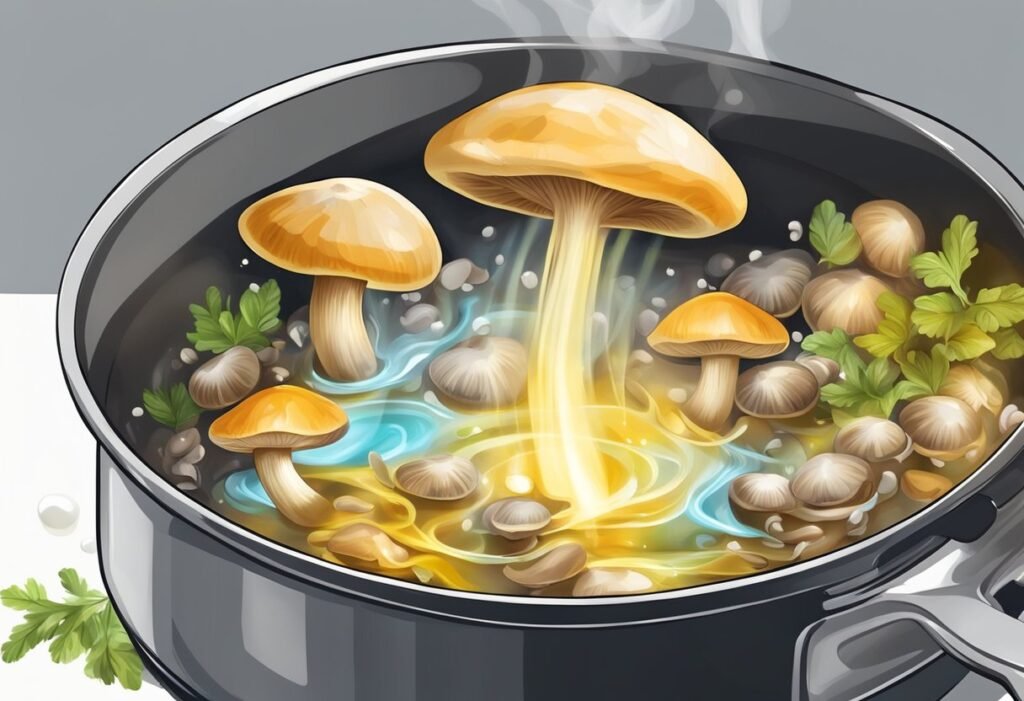Mushroom oil is a versatile ingredient that can be used to add flavor to a variety of dishes. Whether you’re a professional chef or a home cook, knowing how to make mushroom oil will help you take your cooking to the next level. The process of making mushroom oil is relatively simple, and with a few ingredients and some patience, you can create a delicious and aromatic oil that will enhance the flavor of your dishes.

To make mushroom oil, you will need fresh mushrooms, oil, and some basic kitchen tools. There are several different methods for making mushroom oil, but most involve infusing oil with mushrooms to create a flavorful and aromatic oil. The type of mushroom you use will affect the flavor of the oil, so it’s important to choose a mushroom that complements the dish you plan to use the oil in.
In this article, we will walk you through the process of making mushroom oil step-by-step, from selecting the right mushrooms to storing and using your homemade oil. We will also provide tips and tricks for getting the most flavor out of your mushrooms and creating an oil that is both delicious and versatile. So, whether you’re looking to add a little extra flavor to your soups and sauces or you want to create a unique and flavorful salad dressing, read on to learn how to make mushroom oil.
Understanding Mushrooms

Types of Mushrooms
Mushrooms come in a variety of types, each with its own unique flavor, texture, and nutritional value. Some of the most commonly used mushrooms include:
- Button mushrooms: These are the most common type of mushroom and have a mild, slightly earthy flavor. They are often used in soups, stews, and sauces.
- Shiitake mushrooms: These have a meaty texture and a rich, savory flavor. They are often used in Asian dishes and can also be sautéed and used as a topping for salads or pizzas.
- Portobello mushrooms: These are large, meaty mushrooms with a rich, earthy flavor. They can be grilled, roasted, or sautéed and used as a vegetarian alternative to meat.
- Oyster mushrooms: These have a delicate, slightly sweet flavor and a velvety texture. They are often used in stir-fries, soups, and stews.
- Morel mushrooms: These have a nutty, earthy flavor and a spongy texture. They are often used in sauces and soups.
Nutritional Value
Mushrooms are a great source of nutrients and are low in calories, making them a healthy addition to any diet. They are rich in vitamins and minerals such as vitamin D, potassium, and selenium. They are also a good source of protein and fiber.
In addition to their nutritional value, mushrooms also have medicinal properties. Some studies have shown that they may help boost the immune system, reduce inflammation, and even help fight cancer.
Overall, mushrooms are a versatile and nutritious ingredient that can be used in a variety of dishes. Understanding the different types of mushrooms and their nutritional value can help you make informed choices when cooking with them.
Ingredients Needed

When it comes to making mushroom oil, the ingredients are relatively straightforward. You will need to have the following on hand:
Mushroom Selection
The type of mushroom you choose will have a big impact on the flavor of your oil. Some popular options include shiitake, porcini, and chanterelle mushrooms. It’s important to choose fresh, high-quality mushrooms with a strong aroma and no signs of spoilage or decay.
Oil Selection
You can use a variety of oils to make mushroom oil, but some of the most popular options include olive oil, grapeseed oil, and avocado oil. It’s important to choose a high-quality oil that will complement the flavor of your mushrooms.
Additional Ingredients
In addition to mushrooms and oil, you may want to add some additional ingredients to your mushroom oil to enhance the flavor. Some popular options include garlic, thyme, rosemary, and black pepper. You can also add a pinch of salt to bring out the flavors of the other ingredients.
Overall, making mushroom oil is a simple process that requires just a few high-quality ingredients. By selecting the right mushrooms and oil and adding a few additional ingredients, you can create a flavorful and versatile oil that can be used in a variety of dishes.
Preparation Process
Cleaning Mushrooms
Before starting the preparation process, it is important to clean the mushrooms properly. Mushrooms can be cleaned by wiping them with a damp cloth or using a soft brush to remove any dirt or debris. It is important not to wash mushrooms with water as they can absorb it and become soggy.
Heating Oil
Once the mushrooms are clean, they can be sliced or chopped into small pieces. In a saucepan, heat the oil over low heat until it reaches a temperature of around 120°F. It is important not to overheat the oil as it can burn the mushrooms and give the oil a bitter taste.
Infusion Process
Add the sliced mushrooms to the heated oil and stir well. Let the mushrooms infuse in the oil for at least 30 minutes, stirring occasionally. The longer the mushrooms infuse, the stronger the flavor of the oil will be. Once the infusion process is complete, strain the oil through a fine-mesh sieve or cheesecloth to remove any solid particles.
By following these simple steps, one can easily make mushroom oil at home. It can be used as a flavor enhancer in a variety of dishes such as soups, pastas, and salads.
Storing Mushroom Oil
Suitable Containers
When it comes to storing mushroom oil, it is essential to choose the right container to maintain the quality and freshness of the oil. A glass bottle with a tight-fitting lid is an ideal container for storing mushroom oil. Glass is non-reactive and does not affect the flavor or quality of the oil. Additionally, the tight-fitting lid prevents air from entering the bottle, which can cause the oil to spoil quickly.
Another suitable container for storing mushroom oil is a stainless steel bottle. Stainless steel is non-reactive and does not affect the flavor or quality of the oil. However, it is essential to choose a bottle with a tight-fitting lid to prevent air from entering the bottle.
Shelf Life
The shelf life of homemade mushroom oil depends on various factors, such as the type of oil used and the storage conditions. Generally, mushroom oil can last for up to a month when stored in a cool, dark place away from direct sunlight. However, it is best to use the oil within two weeks to ensure maximum freshness and flavor.
It is crucial to check the oil’s smell and taste before using it in a recipe. If the oil smells rancid or has an off-taste, it is best to discard it. Additionally, if you notice any signs of mold or discoloration in the oil, it is not safe to consume and should be thrown away immediately.
In conclusion, storing mushroom oil in a suitable container and under the right conditions is essential to maintain its quality and freshness. By following the tips mentioned above, you can ensure that your homemade mushroom oil lasts longer and adds a delicious flavor to your dishes.
Usage of Mushroom Oil
Culinary Uses
Mushroom oil is a versatile ingredient that can be used to add a rich and earthy flavor to a wide range of dishes. Here are some of the most common culinary uses of mushroom oil:
- Finishing oil: Mushroom oil can be used as a finishing oil, just like you would use a drizzle of extra virgin olive oil. A few drops of mushroom oil on top of a soup, risotto, or grilled steak can add a burst of flavor. Remember, mushroom oil is a concentrated ingredient, so a little goes a long way.
- Marinades: Mushroom oil can be used as a key ingredient in marinades for meats, vegetables, and tofu. The oil helps to tenderize the food and infuse it with a rich, savory flavor.
- Sauces: Mushroom oil can be used as a base for sauces, such as mushroom gravy or mushroom cream sauce. The oil adds depth and complexity to the sauce, and can be used in combination with other ingredients like garlic, shallots, and cream.
Medicinal Uses
Mushroom oil has been used for centuries in traditional medicine to treat a wide range of ailments. Here are some of the most common medicinal uses of mushroom oil:
- Immune support: Certain types of mushrooms, such as shiitake and reishi, have been shown to have immune-boosting properties. Mushroom oil made from these varieties of mushrooms may help to support the immune system and promote overall health.
- Anti-inflammatory: Some types of mushrooms, such as maitake and oyster mushrooms, have anti-inflammatory properties. Mushroom oil made from these varieties of mushrooms may help to reduce inflammation in the body and alleviate symptoms of conditions like arthritis.
- Antioxidant: Many types of mushrooms are rich in antioxidants, which help to protect the body against damage from free radicals. Mushroom oil made from these varieties of mushrooms may help to promote overall health and reduce the risk of chronic diseases.
Final Verdict
Making mushroom oil is a relatively simple process, and the end result is a versatile and flavorful ingredient that can be used in a wide range of dishes. By following the steps outlined in this guide, anyone can make their own mushroom oil at home.
One of the key advantages of making mushroom oil is that it allows you to use up mushrooms that might otherwise go to waste. Additionally, the oil can be stored for long periods of time, making it a convenient ingredient to have on hand.
When making mushroom oil, it is important to choose fresh and high-quality mushrooms. The type of mushroom used will also impact the flavor of the oil, so it is worth experimenting with different varieties to find the one that best suits your tastes.
Infusing the oil with garlic and herbs can help to enhance the flavor of the mushrooms, while using a high-quality oil such as olive oil or avocado oil will ensure that the final product is both flavorful and nutritious.
Overall, making mushroom oil is a great way to add depth and complexity to your cooking, and it is a skill that any home cook can master with a little practice.




